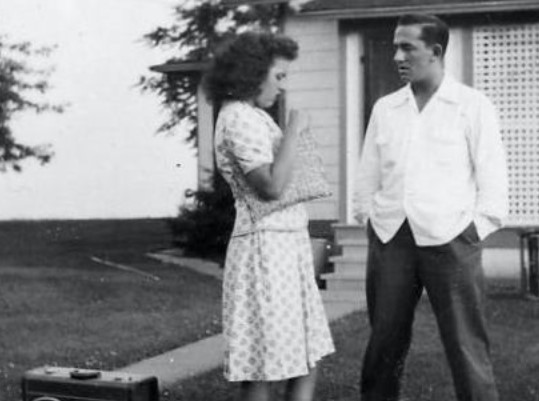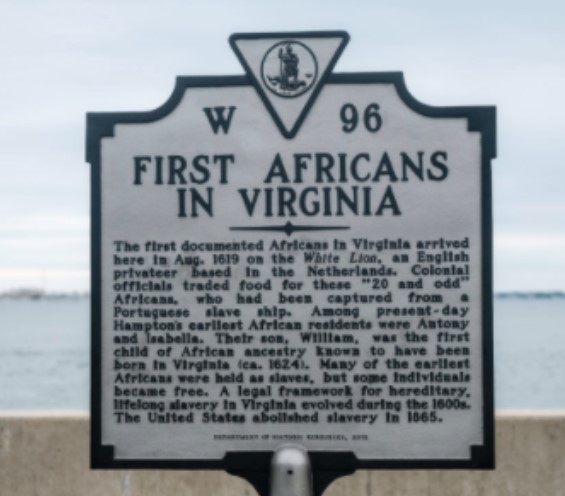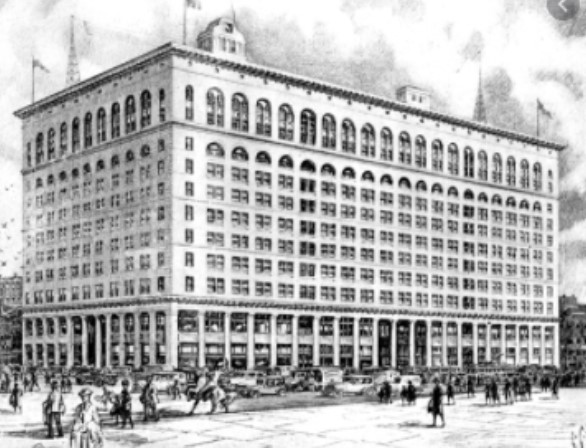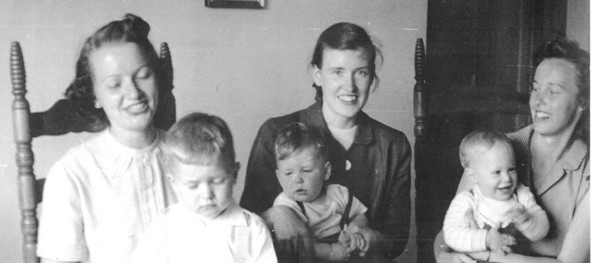America, Then and Now
Editor’s Note: There is more going on today than I can process. It includes the physical presence of a Direct installation specialist, a strange smooth voice from the Subcontinent and upgraded equipment. So, in the interest of “context,” this is how we arrived in the Great Room at Refuge Farm in the morning. It is not bad, but with a second impeachment also in progress, an inauguration looming, and untruths flying in all directions, I thought I would recount how we arrived there. A lot of emotion involved in that, too. If we have a “black swan” event between now and then, I will keep you posted.
– Vic
15 January 2021
America, Then and Now

(Betty in the midst of mighty change. That is young Bill to the right).
There has been a remarkable series of events lately conducted in this remarkable republic. The current controversy is about race and racism, something that is entwined in our remarkable shared history. It erupted in this new generation as a basis of anger in what we are supposed to celebrate as “diversity” in the context of a “systemically racist” society.
The best example was celebrated a couple years ago by what used to be our foremost newspaper of record, the New York Times. I was a subscriber for many years, particularly when I was serving in the armed forces overseas. The Times abandoned the pretense of objective journalism a while ago, and one of the biggest statements was publication of a curious thing called “The 1619 Project.” In short, it was a journalistic effort to reframe American history. It was celebrated on release, since it invented a new history that dated the republic not from 1776, when we cast off the rule of a British King, but from the arrival of the first boatload of chattel slaves in Virginia.

It was a political screed, as I noted at the time, since the legality of slavery on the Northern component of this continent was nothing new, having been practiced by the indigenous people for hundreds of years, and by the Portuguese and Spanish colonialists to the south much earlier. Despite being a political polemic, the 1619 date is curious, since the vile institution was considered legal by the King who ruled here. They are ripping down statues of Thomas Jefferson, a Virginian who owned other human beings, in celebration. Jefferson also took action as President to ban the importation of new slaves in 1808, which could be another memorable date to go along with Lincoln’s emancipation of slaves in the territories of the Confederate states in 1863. They are ripping down his statues, too.
If there was a statue of the King around, my family would probably feel good about the idea of ripping it down, since it was by Royal policy that we were expelled from their homelands to cross the gray and angry sea. One of the topics of discussion in modern times is the provision of reparations to the descendants of slaves by those who did not own them. So, today’s tax dollars are to be taken from families who owned no slaves and given to families who were not slaves. That is a little abrupt in description, though true enough for shorthand. The more complicated end of it is…complicated.
The King is involved right up to 1776, of course. And that is where it becomes a family matter for our clan. My experience with racism in America has always been a family matter. In our history, the Clendenin branch came from Scotland, and were part of the radical change in population there orchestrated by the British sovereign. It is said he preferred glens filled with sheep over ones filled with young men with swords. Reasonable enough on his part, I suppose, but a brutal policy for those who were expelled from the glens. Most of our assorted ancestors, the Scots and later the Irish, shared that history of expulsion from their ancestral homelands. The House of Windsor is still there. Our various houses are not. They are here. The passage west was undoubtedly kinder than that from Africa, but there was unquestionably hardship and death for some.
Not having much choice, we managed to do pretty well in America. The Clendenins were a pretty enthusiastic bunch, and after arrival in north America apparently still bore some hostility to the King. Several of them were of fighting age and joined the Continental Army to fight him. They actually earned the term “patriot” which is now thrown around a lot. The Clendenins were authentic and original. My Aunt Barbara searched out the genealogy in order to qualify for membership in a related social organization called the “Daughters of the American Revolution,” or what we know as the DAR.
The Daughters were not a revolutionary organization, except in heritage. They are still around, though not nearly as influential as they were in the past. In fact, one of the latest remarkable things entwined in our current historical controversy is the elimination of familiar family identifications in the House of Representatives. Like “Mother” and “Father.” And of course, sons and daughters. The motivation for all this apparently is derived from an old bromide about destroying the family itself in order to promote a wiser and centrally controlled social organization. One in which I would not be able to grandly plow into the scraps left from ten or twelve generations on this soil. Like the 1619 Project attempts to do, someone could just tell us what to believe based on what they think should be true.

(Wanamakers now stands where the family saloon was located in central Philly after the Revolution)
From my aunt’s research, we learned that after war service, one of our Clendenins opened a tavern on the block in central Philadelphia that now features the grand old Wanamakers department store. It is listed as a national historic monument now. That part of the family still had relations with what became my family as late as 1903, when my great grandfather visited them in Philadelphia before boarding ship for the beginning of his European Grand tour. Actual relations have dwindled, but the name is still alive as the middle name of my sister.
Mom’s family was mostly Irish, arriving in the Potato Famine year of 1848 in Alexandria, Virginia. That side fought on both sides of the Civil War. I have a manuscript I wrote during a time of interest about the schism in that family. It is about “Love and War in the West,” since my G-G-G-Uncle Pat Griffen was a young man who went to war for Tennessee in the 10th Infantry- Irish. He liked the mayor of his hometown, Nashville, and served in Colonel McGavock’s unit.
I have been to the place where his Colonel fell in combat. It is a placid place today in a state called Mississippi today, but it wasn’t then. Uncle Pat carried the body into town and got it into temporary but honorable internment. After escaping Union captivity, he went on fighting against the Yankees through the Georgia campaign on the personal staff of John Bell Hood. He was, at least by his account, a specialist in blowing up and derailing trains. He lived a long life after the war and was active in Confederate veteran groups. His stories of the War are reviled by historians these days as being inaccurate and self-aggrandizing.
The War ripped our family asunder. Uncle Pat’s father had died at work on construction of the Gordonsville-Nashville railroad. The surviving members of the Griffen family relocated to Nashville. There was a daughter who had an alert eye. She found a bluff young Irish man in the service of the Union troops who occupied her town after the Vicksburg siege. She convinced my G-G-G-grandfather not to return to his unit after he had re-enlisted for a cash and home leave bonus. My cousin Hal and I were surprised to discover he was termed a ‘deserter’ after we investigated the absence of a Civil War Service marker on his grave.
Like the Clendenins, he opened a general store after hostilities died and the Union Army occupied the states of the insurrectionists. But the immediate post-war years did not leave much for me to work with as a family archivist. My grandfather Mike Foley was a railroad man, but an engineer and not a hammer swinger. He was a Doughboy in the First War. He was as colorful a man as Uncle Pat, a renowned athlete in his time and a Bonus Army Marcher in Depression days. My Mom remembered going down to the train station to see him off to Washington for the demonstration there demanding a cash bonus for his war service.
He and his comrades were run out of DC by General Douglas MacArthur’s orders, which accounts for my distaste for the great General. He died as the American involvement in the Second War was starting. It was a decade at least before my own arrival on the planet. Mom performed some of the same research into the Irish side that Aunt Barbara did for the Scottish family. She had some fascinating stories about her family life in the little river and rail town in Ohio. Grandma was a strong woman, though I did not know just how strong when I knew her as a kind old woman doting on little me and brother and sister.
Here is an example: once, she heard a rumor of Grandpa’s dalliance with a young woman in town. She wheeled one of her girls- I don’t know which one- in a stroller past the home of the young lady to demonstrate the consequences of play with a strong and athletic older man.
So, after Grandpa died, the railroad sent a man to the house and told her that the pension was stopped, and she and her three girls were on their own. Grandma took a job as a sort of office manager for the local lumber company, which I think is where she met the man who later served as our Grandpa. In the midst of all that, Mom was valedictorian of her high school class in Bellaire, Ohio, and won a scholarship to be the first of her family to attend college.
This was during the Second War, and America was in the process of turning itself inside out and upside down to support the mobilization. One of her professors was called to serve The Texas Company in New York, headquartered in the amazing Chrysler Building in Manhattan. She had impressed him with her energy- there are stories of how she made her own way in college in the accelerated academic program to produce young men for service. One of them involved getting in trouble for exiting one class through a window to make another across campus. When she graduated, a sorority member of Alpha Xi Delta, her old professor called her to join his company, and she told me one time of her departure from the Ohio Valley to Manhattan. Grandma walked her to the train. Mom said she was a little scared by what she was about to do. Grandma told her she could do it if she was brave, gave her a kiss, and sent her off. Alone. On a train, bound for the most exciting city in America.
She lived in a woman’s hotel there. I have a picture of it somewhere, maybe the Webster Hotel. By this time the war in Europe was over, and the boys were flooding back home. One of the boys from Bellaire looked her up when passing through and gave her a Hitler Youth flag he had liberated from Germany in an attempt to gain her favors. It didn’t work, though I still have the flag, neatly folded, and still with the original Reichzugmeistry tags on it.
She remembered the name of the young man who brought it back, but it has faded in my recollection. She later did agree to go on a blind date with a young guy recently released from his service in one of the last classes of Naval Aviators commissioned as the war ended. Dad said he was the third to last class to get his wings in the wartime effort as the European peace began and the preparations for the landings in the Japanese home islands ended with the use of the A-Bombs at Hiroshima and Nagasaki. He was trained as a dive-bomber pilot, but that line of work suddenly dried up.

(Betty, middle, her sisters and the next generation, 1953 or so)
Betty and Bill’s relationship took, and they were married in 1948 at the Little Church Around the Corner in mid-town Manhattan. On their 60th Anniversary, they renewed their vows in the same church, and most of us were there to help them celebrate. In the meantime, Dad completed his studies as an industrial designer. He heard about work in Detroit from his pal, Bob Veryzer, and he and Betty drove their Model A Ford west to the motor city and took a position with Ford as a clay modeler in the design studio. That was one of the stages in auto design that no longer exists. He worked on some interesting projects, one of which was the Ford Levacar, a semi-flying vehicle of the future. I can see some of the shapes in that design from Dad’s other automotive work, but I can’t ask him now whether he contributed his love of aeronautical shapes to the futuristic design or the other way around.
Screen Shot 2021-01-14 at 1.19.44 PM.png
(The Ford Levacar with the company Big Wigs)
That is almost to the point of my own vague memories, which included play on the lawn of a little house on Kentucky Street in Detroit, near the D&W Oil refinery. That was the first collision with racial politics for our family I am aware of. Dad’s family had lived in a town called Shippensburg in Pennsylvania and most of us still get buried there. The family was occupied for a day or two by Confederate troops headed for a farming community to the northwest called Gettysburg, so we were oppressed by the Army defending the oppression of slaves. Being occupied by heavily-armed people who believe strongly in things you don’t used to be fairly unusual in this country.
It is hard to understand the impact of the great mobilization on America, or at least it was until the Corona Virus struck us last year. During the War, Detroit became known as the Arsenal of Democracy. It had a need for labor with the troops overseas. African Americans moved north to take them, and Detroit had the same de facto segregation as was common in the 1950s. A Real Estate practice at the time involved moving a black family into what were white neighborhoods. “Block busting” is what it was called, and it produced “white flight.” The folks moved us from Kentucky street to Birmingham, a pleasant little suburban town outside Eight Mile, the northern City Limits. I still have a couple memories of life on Kentucky Street, but childhood was spent outside the place that was struggling for housing and jobs in the factories.
(Lyndon and Dr. King photo in 1965. The latter was one of my heroes).
My memories of the effects of racism only go back to the vigorous discussion about the Voting Rights Act of 1965. I didn’t have much to do with it, of course, but Mom ensured I followed the matter with youthful interest. She was a president then, too, of the Birmingham League of Women Voters. Barry Goldwater, the Republican Senator from Arizona convinced me, in his public discourse, that something needed to be done about the Jim Crow laws. States and municipalities across the old Confederacy had instituted repressive laws aimed at black citizens, and the name for it originated in a disparaging black character popularized by a white man named Thomas D. Rice. Rice was a New York City kid from a mixed neighborhood. He performed across the South before the War and was inspired by a stableman in the 1830s to create his rendition of a slave in the upper South. It was done in black-face with a signature dance. The character assumed its highest popularity in the decade before the Civil War.
After the end of Reconstruction, local laws infringing on civil rights were referred to in the name of the old slave character. In my time, Goldwater was a constitutionalist and felt that the matter needed to be addressed the same way it had been created. As a state and local matter. The bedraggled 10th Amendment was his justification.
It didn’t work out that way. After JFK’s murder and Lyndon Johnson’s assumption of power, the drive for national control of the issue resulted in the Civil Rights Act of 1964. The Voting rights Act followed the next year, specifically targeting restrictive practices like the literacy test. These and other laws were banded together in a program Johnson called “The Great Society.” One of my favorite Democrats, Senator Daniel Patrick Moynahan, characterized the unintended consequences of the dramatic change to the social order. Single mothers received direct payments to enable them to and their children to survive without husbands. Moynahan explained that one of the real consequences of The Great Society was to destroy the African-American family. The number of out-of-wedlock children expanded dramatically, and naturally that trend did not restrict itself to minority women.
That is where racism visits most of my generation. Today’s rhetoric is impassioned, just as a well-intended effort with vast unintended consequences was discussed a half century ago. The imposition of social mechanisms like “Affirmative Action” have been with us now for a very long time. So have entitlements that provide a government-provided income stream outside traditional family structures. There will be more. Our next President last night told us $1.9 trillion of them.
One of the incoming Biden Justice officials, Kristen Clarke, has asserted that neuro-melanin compounds provide significant advantages in mental acuity, spirituality and athletics to people who have the right quantities of it. I support her First Amendment right to say what she thinks, though find the literal version of what she said to be a curious inversion of the rhetoric that old Dixiecrats used to proclaim. And were damned for.
Oh, forgot to include it, but the controversy over who fought for what sundered the old family, and some of them moved down the river from Tennessee. They might have wound up as Dixiecrats, but I don’t know. We haven’t talked in a century.
Old wars and new. We have been in all of them. And given what is going on today, one of them was invisible.
Copyright 2021 Vic Socotra
www.vicsocotra.com
